Analytics from the carpet: a review of the "new" 18 years ago
Hi, Habr.
While visiting relatives in St. Petersburg, I saw a very curious picture. Residents removed the carpet, under which (apparently for the sake of economy), no wallpaper was pasted - the walls were plastered with computer newspapers from 2001-2002, which remained in near-perfect condition. It became interesting what was sold then and what was relevant.

')
Who is also interested in what can be found, details under the cut (carefully, traffic).
The first thing that catches your eye is that all prices are in US dollars. Now it has long been unusual, and then not only the prices were in USD, but it was possible to pay in the store in the same way.
Speaking of course. If you believe Google, the dollar then cost 29 rubles, and the average salary was 2,200 rubles, i.e. about $ 75. The programmers salary was, of course, more, and could be as much as $ 200, and they could pay it directly in the envelope in these same USD (I imagine the happiness of American managers who can hire several programmers for the salary of an American cleaner at McDonalds :).
Edit: as suggested in the comments, senior programmers could get more, but then it was still exotic, it can be assumed that there was practically no developed market for professional programmers in the early 2000s (to be a "senor" in 2000m, you had to to learn and work in the 90s, and the IT market was then in its infancy).
The manufacturers themselves have not changed much: IBM, Maxtor, Samsung, Seagate. The cheapest disc was a 20GB WD with 2MB of cache memory, priced at $ 64. The most expensive was the WD 120Gb with 8MB cache as much for $ 192.

Interestingly, the speed of rotation of the disk has not changed, and as now, is 5400 or 7200rpm.
If we are talking about disks, one can not forget the now forgotten magneto-optical drives. The “diskette” of the Iomega ZIP drive was exotic — as much as 100MB on disk (for $ 13) and $ 100 for the drive itself.

About any LCD then almost not heard. More precisely, they already were, lay 1-2 pieces for the entire store, which they went to look like in a museum, about the same way they are watching 48 "8K TV. But the usual" worker-peasant "monitor was 15" CTX with a resolution of 1280x1024. The chic was a Sony 17 "monitor with a resolution of 1600x1200x75Hz.
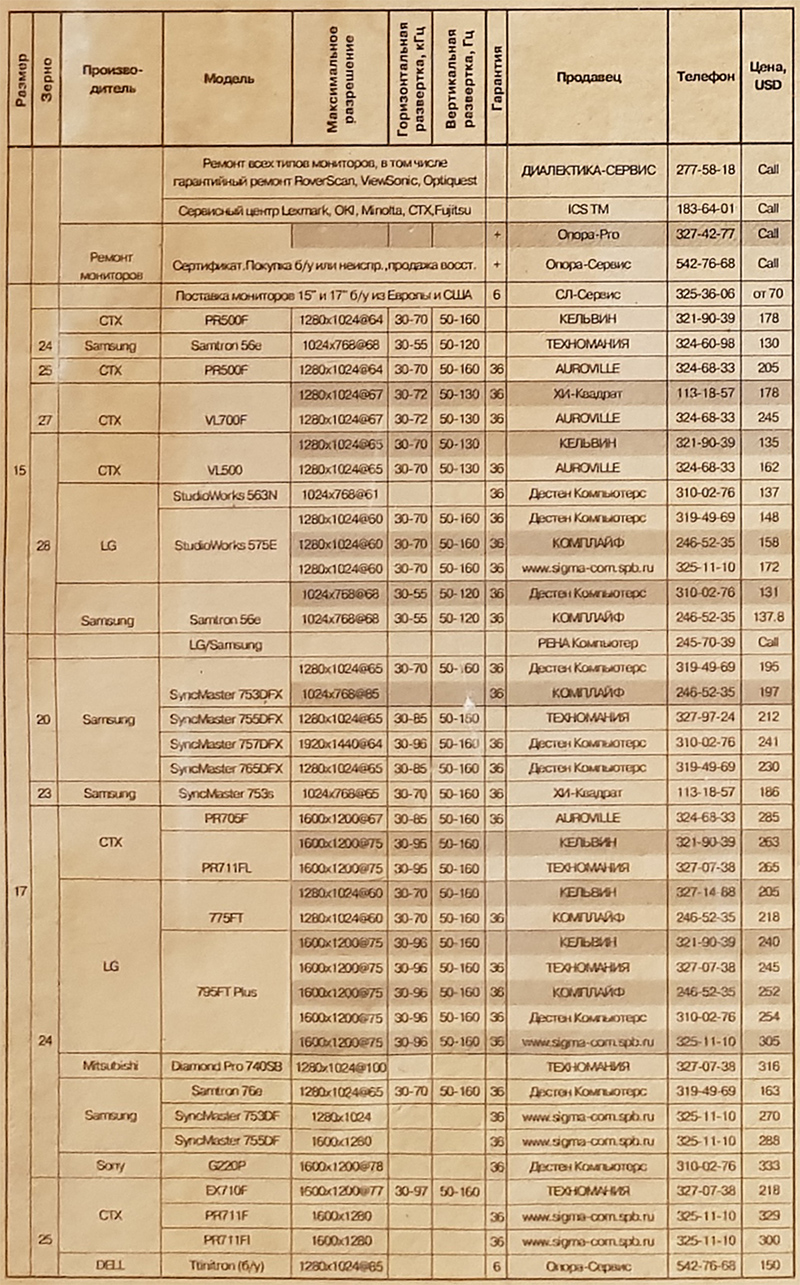
LCD monitors, however, could be found if desired:
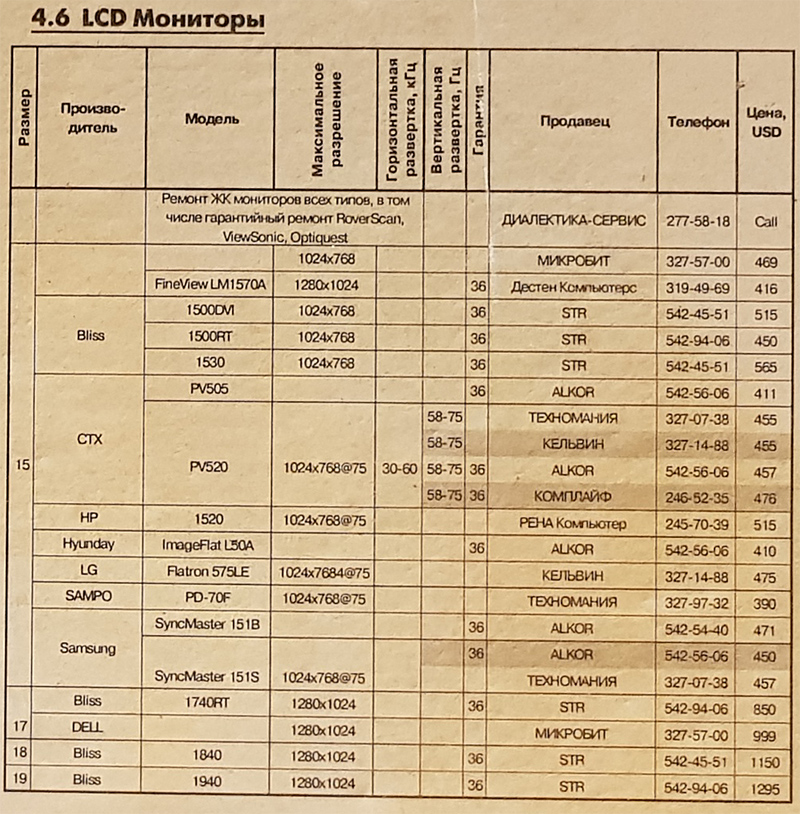
Oddly enough, they were already there (or maybe a newspaper sheet came from another year :).
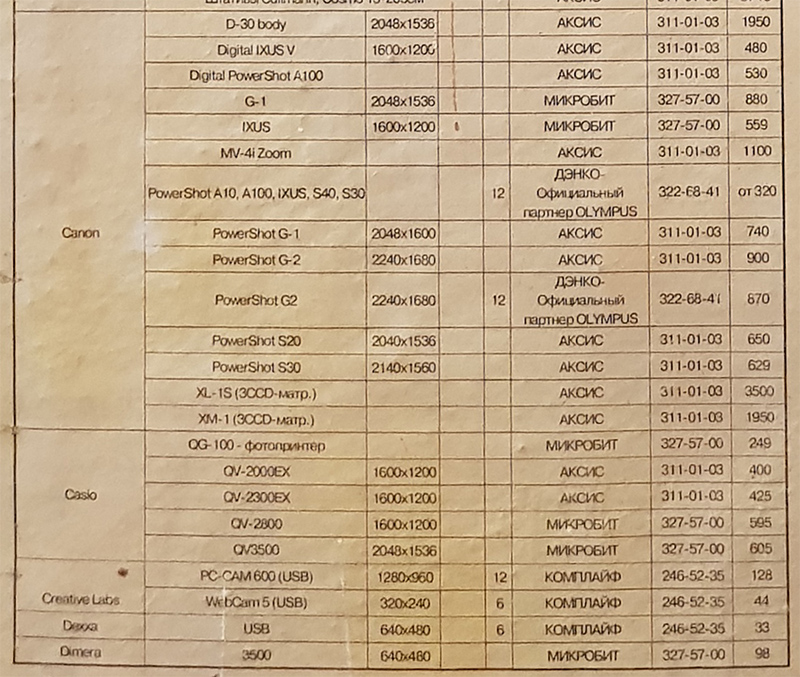
The top of the top is occupied by the Canon d30 carcass - a professional camera with a resolution of as much as 3MPx (2048x1536) and an astronomical price of $ 1950, roughly equal to the annual salary of a Russian engineer (by the way, it's interesting that modern Sony A7 digital mirrors cost about the same in USD). The Canon IXUS pocket digital camera with a resolution of 2MPx (1600x1200), about $ 500, was simpler. Canon Powershot G1 cameras were available for enthusiastic amateur photographers for $ 740 with a resolution of 2048x1600. Of the interesting cameras can be noted Olympus C-700 Ulrazoom with 10x zoom, 2MPx resolution and price of $ 550.
By the way, the Canon Ixus was my first digital camera outlet, which made quite good shots, even by today's standards (except for permission, of course). Especially it is necessary to pay attention to the dynamic range - due to the large pixel size, the camera transmitted light and shadows quite well:

As for the price of memory carriers, the CompctFlash 128 MB card cost $ 51, and the top of the progress was IBM Microdrive as much as a whole gigabyte (with unspecified price). If someone did not remember or found, it was a real hard disk in the format of a memory card. For $ 75, it was possible to buy a PCMCIA adapter for reading memory cards - a standard that has become extinct now, and once they were not only in laptops, but even in some handheld computers.
Another sign of the time is a dial-up modem, which provides Internet access via a telephone channel with an inconceivable speed of up to 56 Kbps.

Prices as you can see, ranged from $ 30 for a PCI-Winmodem to $ 170 for a top-end external and beautifully flashing LED, 3COM Courier.
Access to the Internet itself was generally not cheap. For $ 15, it was possible to buy a “nightly” monthly dial-up package from 2.00 to 8.00, and the prices for hourly access were about 0.5 $ / hour.
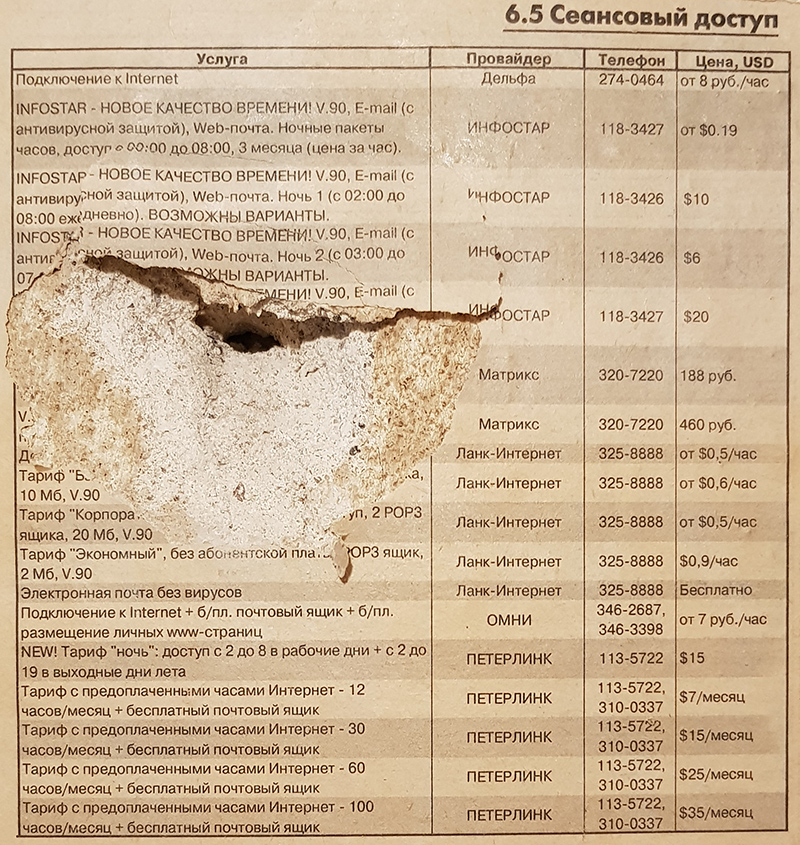
(sorry for the hole in the wall :)
Laptops were, to put it mildly, not cheap. The “poor student” could only count on a used laptop level 486DX100, the average configuration was a computer with a 750MHz Pentium-III processor, 256MB of memory and a 1024x768 SVGA screen, costing $ 1500-2500 depending on the configuration. Separately, the ultra-light notebook weighs only 1kg and costs almost $ 2899.

Handheld computers were mainly presented in two types. Palm family - different models, from Palm m105 to Palm m515 . The latter had a color screen with a resolution of 160x160 pixels now incredible and 16MB of memory. However, it was already the time of sunset Palm OS - iPAQ and Jornada appeared on the market with Windows Mobile and a 200 MHz processor. The first Palm s were exclusively business organizers, but the multimedia era was already beginning - users wanted not only to read texts, but even play MP3s (few people thought about movies on handheld devices then).
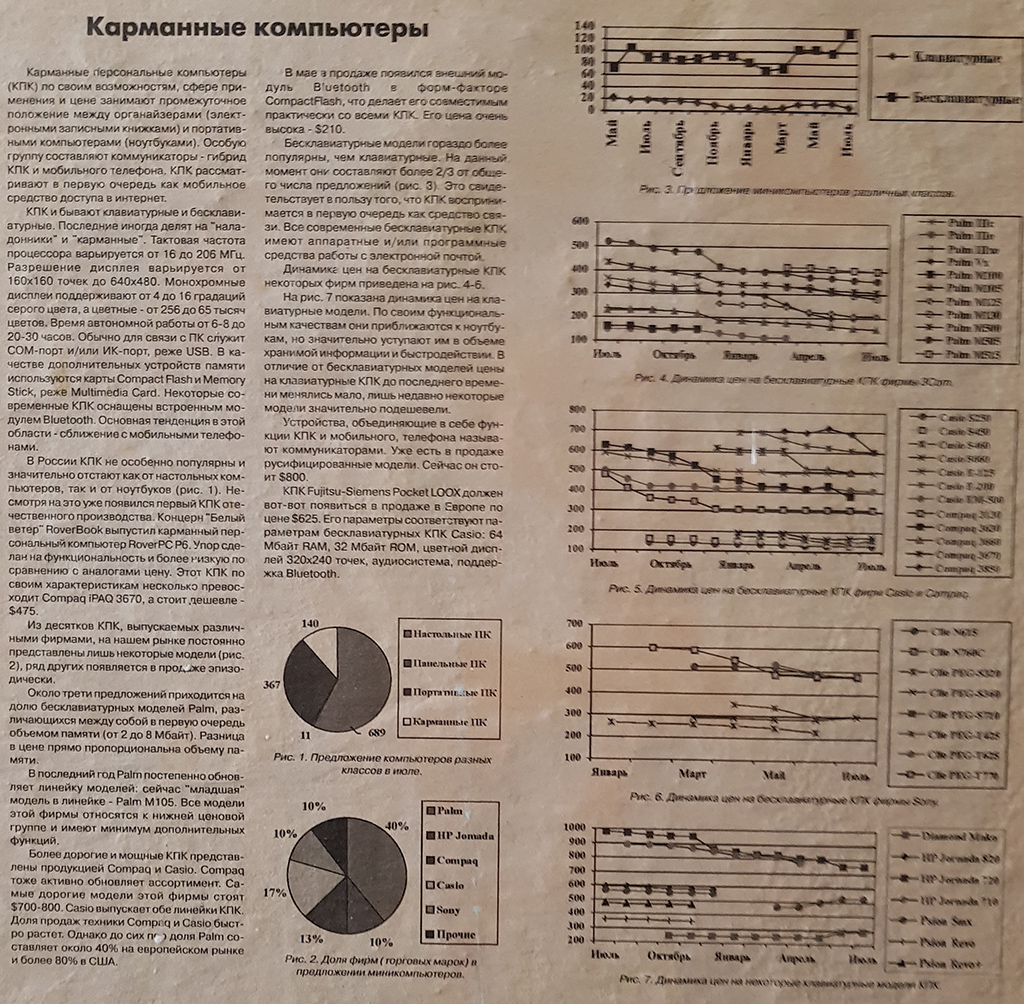
Speaking of MP3. There were already CD / MP3 and MP3 players on the market.
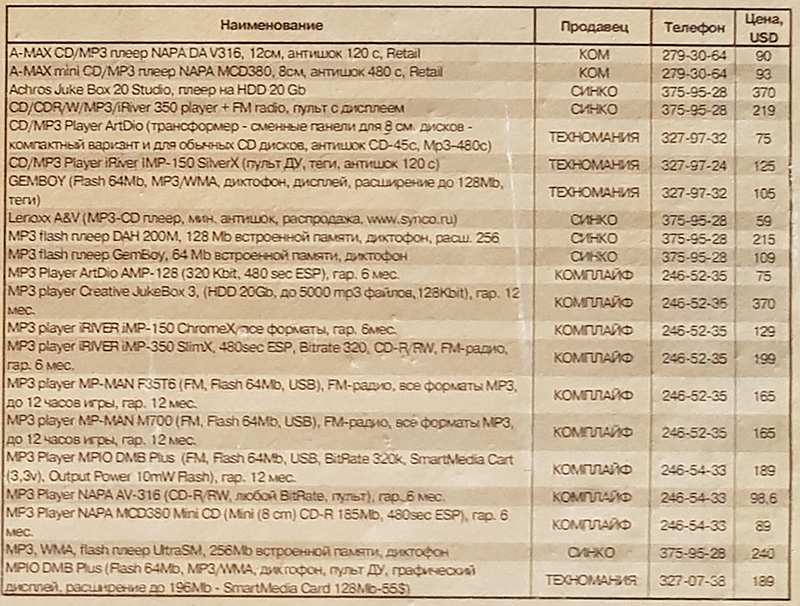
For about $ 100 you could buy a rather bulky device that can play CDs and MP3s. For aesthetes, it was possible to buy for $ 210 to buy a flash player with a memory capacity of as much as 128MB. It was an era when music was downloaded from friends or discs were changed in stores. There was still 6 years left until the release of the iPod Touch, 5 years before the release of Spotify.
Buying Windows or Photoshop was, and still is not very popular in Russia, so there are very few software offers. But we managed to find a licensed Windows 95 and even the forgotten Lexicon. "1C" turns out, it was already then, although I do not understand its versions at all. But it’s hard to say what Descartes or Socrates is, who knows, write in the comments.
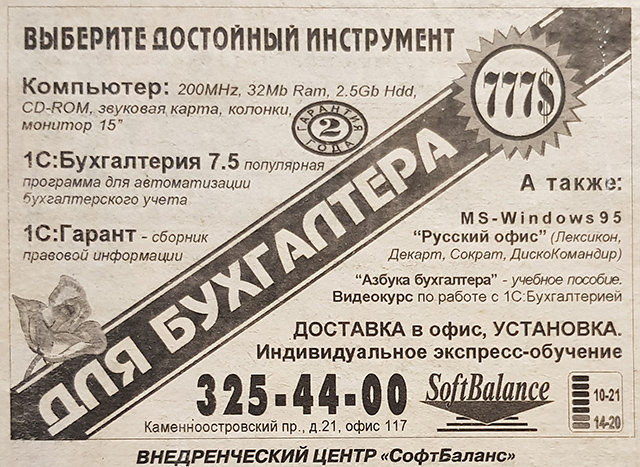
Interesting was the fact that 18 years ago, in the seemingly "dense" times, in principle, everything was already (although not for everyone). From a 1.2kg laptop, handheld computer or digital camera, up to a 19 "LCD monitor. Only it was a mega-super Hi-End, and the prices were appropriate.
And finally, despite the availability of webarchive services, the old newspaper on the wall will probably remain an interesting source of information for a long time. True, newspapers are also a thing of the past.
Let's see what will remain “descendants” in the next 18 years ...
While visiting relatives in St. Petersburg, I saw a very curious picture. Residents removed the carpet, under which (apparently for the sake of economy), no wallpaper was pasted - the walls were plastered with computer newspapers from 2001-2002, which remained in near-perfect condition. It became interesting what was sold then and what was relevant.

')
Who is also interested in what can be found, details under the cut (carefully, traffic).
Prices in USD
The first thing that catches your eye is that all prices are in US dollars. Now it has long been unusual, and then not only the prices were in USD, but it was possible to pay in the store in the same way.
Speaking of course. If you believe Google, the dollar then cost 29 rubles, and the average salary was 2,200 rubles, i.e. about $ 75. The programmers salary was, of course, more, and could be as much as $ 200, and they could pay it directly in the envelope in these same USD (I imagine the happiness of American managers who can hire several programmers for the salary of an American cleaner at McDonalds :).
Edit: as suggested in the comments, senior programmers could get more, but then it was still exotic, it can be assumed that there was practically no developed market for professional programmers in the early 2000s (to be a "senor" in 2000m, you had to to learn and work in the 90s, and the IT market was then in its infancy).
Hard drives
The manufacturers themselves have not changed much: IBM, Maxtor, Samsung, Seagate. The cheapest disc was a 20GB WD with 2MB of cache memory, priced at $ 64. The most expensive was the WD 120Gb with 8MB cache as much for $ 192.

Interestingly, the speed of rotation of the disk has not changed, and as now, is 5400 or 7200rpm.
If we are talking about disks, one can not forget the now forgotten magneto-optical drives. The “diskette” of the Iomega ZIP drive was exotic — as much as 100MB on disk (for $ 13) and $ 100 for the drive itself.

Monitors
About any LCD then almost not heard. More precisely, they already were, lay 1-2 pieces for the entire store, which they went to look like in a museum, about the same way they are watching 48 "8K TV. But the usual" worker-peasant "monitor was 15" CTX with a resolution of 1280x1024. The chic was a Sony 17 "monitor with a resolution of 1600x1200x75Hz.

LCD monitors, however, could be found if desired:

Digital cameras and accessories
Oddly enough, they were already there (or maybe a newspaper sheet came from another year :).

The top of the top is occupied by the Canon d30 carcass - a professional camera with a resolution of as much as 3MPx (2048x1536) and an astronomical price of $ 1950, roughly equal to the annual salary of a Russian engineer (by the way, it's interesting that modern Sony A7 digital mirrors cost about the same in USD). The Canon IXUS pocket digital camera with a resolution of 2MPx (1600x1200), about $ 500, was simpler. Canon Powershot G1 cameras were available for enthusiastic amateur photographers for $ 740 with a resolution of 2048x1600. Of the interesting cameras can be noted Olympus C-700 Ulrazoom with 10x zoom, 2MPx resolution and price of $ 550.
By the way, the Canon Ixus was my first digital camera outlet, which made quite good shots, even by today's standards (except for permission, of course). Especially it is necessary to pay attention to the dynamic range - due to the large pixel size, the camera transmitted light and shadows quite well:

As for the price of memory carriers, the CompctFlash 128 MB card cost $ 51, and the top of the progress was IBM Microdrive as much as a whole gigabyte (with unspecified price). If someone did not remember or found, it was a real hard disk in the format of a memory card. For $ 75, it was possible to buy a PCMCIA adapter for reading memory cards - a standard that has become extinct now, and once they were not only in laptops, but even in some handheld computers.
Modems
Another sign of the time is a dial-up modem, which provides Internet access via a telephone channel with an inconceivable speed of up to 56 Kbps.

Prices as you can see, ranged from $ 30 for a PCI-Winmodem to $ 170 for a top-end external and beautifully flashing LED, 3COM Courier.
Access to the Internet itself was generally not cheap. For $ 15, it was possible to buy a “nightly” monthly dial-up package from 2.00 to 8.00, and the prices for hourly access were about 0.5 $ / hour.

(sorry for the hole in the wall :)
Laptops and PDAs
Laptops were, to put it mildly, not cheap. The “poor student” could only count on a used laptop level 486DX100, the average configuration was a computer with a 750MHz Pentium-III processor, 256MB of memory and a 1024x768 SVGA screen, costing $ 1500-2500 depending on the configuration. Separately, the ultra-light notebook weighs only 1kg and costs almost $ 2899.

Handheld computers were mainly presented in two types. Palm family - different models, from Palm m105 to Palm m515 . The latter had a color screen with a resolution of 160x160 pixels now incredible and 16MB of memory. However, it was already the time of sunset Palm OS - iPAQ and Jornada appeared on the market with Windows Mobile and a 200 MHz processor. The first Palm s were exclusively business organizers, but the multimedia era was already beginning - users wanted not only to read texts, but even play MP3s (few people thought about movies on handheld devices then).

Speaking of MP3. There were already CD / MP3 and MP3 players on the market.

For about $ 100 you could buy a rather bulky device that can play CDs and MP3s. For aesthetes, it was possible to buy for $ 210 to buy a flash player with a memory capacity of as much as 128MB. It was an era when music was downloaded from friends or discs were changed in stores. There was still 6 years left until the release of the iPod Touch, 5 years before the release of Spotify.
Soft
Buying Windows or Photoshop was, and still is not very popular in Russia, so there are very few software offers. But we managed to find a licensed Windows 95 and even the forgotten Lexicon. "1C" turns out, it was already then, although I do not understand its versions at all. But it’s hard to say what Descartes or Socrates is, who knows, write in the comments.

findings
Interesting was the fact that 18 years ago, in the seemingly "dense" times, in principle, everything was already (although not for everyone). From a 1.2kg laptop, handheld computer or digital camera, up to a 19 "LCD monitor. Only it was a mega-super Hi-End, and the prices were appropriate.
And finally, despite the availability of webarchive services, the old newspaper on the wall will probably remain an interesting source of information for a long time. True, newspapers are also a thing of the past.
Let's see what will remain “descendants” in the next 18 years ...
Source: https://habr.com/ru/post/442998/
All Articles